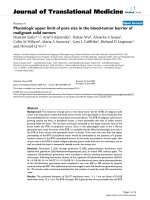Báo cáo hóa học: " In situ Control of Si/Ge Growth on Stripe-Patterned Substrates Using Reflection High-Energy Electron " potx
Bạn đang xem bản rút gọn của tài liệu. Xem và tải ngay bản đầy đủ của tài liệu tại đây (782.57 KB, 7 trang )
SPECIAL ISSUE ARTICLE
In situ Control of Si/Ge Growth on Stripe-Patterned Substrates
Using Reflection High-Energy Electron Diffraction and Scanning
Tunneling Microscopy
B. Sanduijav
•
D. G. Matei
•
G. Springholz
Received: 9 July 2010 / Accepted: 17 September 2010 / Published online: 6 October 2010
Ó The Author(s) 2010. This article is published with open access at Springerlink.com
Abstract Si and Ge growth on the stripe-patterned Si
(001) substrates is studied using in situ reflection high-
energy electron diffraction (RHEED) and scanning tun-
neling microscopy (STM). During Si buffer growth, the
evolution of RHEED patterns reveals a rapid change of the
stripe morphology from a multifaceted ‘‘U’’ to a single-
faceted ‘‘V’’ geometry with {119} sidewall facets. This
allows to control the pattern morphology and to stop Si
buffer growth once a well-defined stripe geometry is
formed. Subsequent Ge growth on ‘‘V’’-shaped stripes was
performed at two different temperatures of 520 and 600°C.
At low temperature of 520°C, pronounced sidewall ripples
are formed at a critical coverage of 4.1 monolayers as
revealed by the appearance of splitted diffraction streaks in
RHEED. At 600°C, the ripple onset is shifted toward
higher coverages, and at 5.2 monolayers dome islands are
formed at the bottom of the stripes. These observations are
in excellent agreement with STM images recorded at dif-
ferent Ge coverages. Therefore, RHEED is an efficient tool
for in situ control of the growth process on stripe-patterned
substrate templates. The comparison of the results obtained
at different temperature reveals the importance of kinetics
on the island formation process on patterned substrates.
Keywords Quantum dots Á Silicon Á Germanium Á
Molecular beam epitaxy Á Patterned substrates Á Reflection
high-energy electron diffraction Á Scanning tunneling
microscopy
Introduction
Self-assembled growth of Stranski–Krastanow islands on
pre-patterned substrates has attracted great interest [1–20]
because it provides an effective route for positioning of
quantum dots in nano-electronic devices. For patterning,
various methods such as optical [1–3], holographic [4–7],
electron beam [5–10], focused ion beam [12–14] as well as
extreme UV interference lithography [15, 16] have been
used, and different pattern geometries, including stripes
[1, 4–6], mesas [2], and pits with various sizes and shapes
[3, 7–17], have been employed. For site-control of deposited
quantum dots, however, the pattern morphology has to be
tightly controlled and the growth conditions tuned to the
given template structure [5–
17]. In particular, perfect site-
control can be achieved only in a limited window of growth
conditions [7, 12–17]. In addition, the shape of the pattern
morphology as well as the growth conditions also deter-
mines where the quantum dots are formed on the surface.
Under different conditions, thus, dot formation was found
to occur at different substrate locations, such as in the
center of pits [7–17], in the middle of grooves [4–6], at
sidewalls [4–6], or even at edges or ridges [1, 2, 10, 12, 15,
16] of the pattern structures. Further complications arise
from the limited thermal budget available for substrate
treatment before epitaxial growth to preserve the pattern on
the surface. Therefore, a buffer layer growth is required to
remove the defects produced by the patterning process.
During buffer growth, however, the pattern morphology
rapidly changes and usually a complex multifaceted sur-
face topography is formed [3–6, 15, 16], which further
B. Sanduijav Á D. G. Matei Á G. Springholz (&)
Institut fu
¨
r Halbleiterphysik, Johannes Kepler University,
4040 Linz, Austria
e-mail:
Present Address:
D. G. Matei
University of Bielefeld, 33501 Bielefeld, Germany
123
Nanoscale Res Lett (2010) 5:1935–1941
DOI 10.1007/s11671-010-9814-8
modifies the dot nucleation process. Therefore, the whole
process sequence must be tightly controlled for reproduc-
ible position control of the quantum dots.
In the present work, we report on in situ control of Si
and Ge growth on stripe-patterned Si (001) substrates using
reflection high-energy electron diffraction (RHEED) and
scanning tunneling microscopy (STM) where large area
patterns were produced by holographic lithography.
Because of the simple geometry, stripes represent a model
system [4–6] for the growth on non-planar substrate tem-
plates with complex surface topographies. Moreover, their
one-dimensional structure allows electron diffraction from
all parts of the surface when the electron beam is directed
parallel to the stripes. This does not apply for two-
dimensional patterns due to shadowing effects. In the
present work, RHEED is employed to study the pattern
evolution during buffer growth from multifaceted ‘‘U’’ - t o
single-faceted ‘‘V’’-shaped stripes in real time, by which a
high reproducibility of the pattern structure is achieved.
Real-time monitoring was also applied during subsequent
Ge growth at different substrate temperatures, revealing the
critical coverages for sidewall ripple formation and 3D
island nucleation. To obtain a real space picture of the
nucleation process, the epitaxial surfaces were imaged in a
step-wise manner using STM, where due to UHV condi-
tions, epitaxial growth could be continued after each
imaging step. In this way, a detailed microscopic picture of
the island nucleation process is obtained.
Experimental
The investigations were carried out in a multichamber
Si/Ge molecular beam epitaxy and scanning tunneling
microscopy system equipped with a Si e-beam evaporator,
Ge effusion cell, and an Omicron variable temperature
STM. Stripe-patterned Si (001) substrates were produced
by holographic lithography and CF
4
reactive ion etching.
The stripes were aligned along the [110] surface direction
and have a lateral period 350 nm and a depth of 40–50 nm
as determined by atomic force microscopy. After standard
RCA cleaning (see e.g. [20]), the native oxide was chem-
ically removed by an HF dip, producing a stable hydrogen-
passivated Si surface. The samples were then loaded into
the MBE system and outgassed and annealed for 15 min at
750°C.
A two-step buffer Si growth procedure was employed to
remove the processing defects and residual surface con-
tamination. It consisted of a first low-temperature Si buffer
layer of 25 nm thickness grown at a temperature of 450°C,
followed by a second Si buffer growth at 520°C. After a
short annealing at 600°C for 5 min, Ge was then deposited
up to a thickness of 7 monolayers (ML) at two different
growth temperatures of T
s
= 520 and 600°C. The Si and
Ge growth rates were 2 and 1.5 A
˚
/min, respectively, as
checked by quartz microbalance as well as RHEED
intensity oscillations. RHEED analysis was done using
25 kV electrons directed parallel to the stripes along the
[110] azimuth direction. The intensity evolution of various
diffraction spots as a function of deposited layer thickness
was measured using a video-based image processing sys-
tem. For STM investigations, the samples were rapidly
quenched at different stages of growth with a rate of
-10°C/sec, and then transferred under UHV to the attached
STM chamber. Imaging was performed at tunneling
currents of around 0.1 nA and applied sample bias of
2–4 V. Due to the low system pressure in the 10
-11
mbar
regime, growth could be continued afterward after a short
annealing for a few minutes at 450°C.
Results
After patterning, the stripes exhibit a nearly rectangular
geometry with vertical sidewalls and a depth of 40–50 nm
[6]. Due to the surface roughness, etching defects, and
residual carbon surface contamination, a spotty RHEED
pattern is observed after hydrogen desorption and anneal-
ing, as shown by Fig. 1a. During Si buffer growth, the
RHEED patterns rapidly evolve as illustrated by the
sequence of diffraction patterns displayed in Fig. 1b–f.
Already after 5 nm Si deposition at 450°C, the surface
quality drastically improves and the initial 3D diffraction
spots completely disappear (see Fig. 1b). Continuation of
buffer growth, results in the appearance of faint additional
diffraction streaks inclined by 25° to the surface normal, as
indicated by the dashed lines in the RHEED pattern of
Fig. 1c recorded after 10 nm Si growth. These diffraction
streaks arise from electrons specularly reflected from the
tilted sidewalls of the stripes. As illustrated schematically
in Fig. 2, the tilt angle a of these streaks with respect to the
(001) specular spot corresponds exactly to the sidewall tilt
angle on the pattern surface. Their appearance thus indi-
cates a rapid flattening of the sidewalls surfaces and a
preferential orientation toward {113} surface facets, which
are inclined exactly by 25.4° to the (001) substrate orien-
tation. Further Si growth at 450°C up to 25 nm (see
Fig. 1d) does not change much the diffractions pattern.
Increasing the buffer growth temperature at this point to
520°C results in a rapid change in the RHEED patterns.
After 2 nm further Si growth (Fig. 1e), the {113} facet
spots sharpen and strongly increase in intensity. This
indicates an initial rapid expansion, i.e., growth of the
{113} sidewall facets of the stripes. During further Si
growth at 520°C, however, the {113} RHEED spots
weaken again and new facet spots near the specular spot
1936 Nanoscale Res Lett (2010) 5:1935–1941
123
appear at a tilt angle of only about 9°, as indicated by the
arrow in the RHEED patterns depicted in Fig. 1f after
17 nm Si deposition. The 9° tilt angle corresponding to a
sidewall facet oriental near {119}, meaning that during the
high-temperature buffer growth step, the sidewall inclina-
tion rapidly decreases due to surface mass transport toward
the bottom of the stripes.
This observation is corroborated by the STM images
presented in Fig. 3a and b that show the pattern structure
after 7 nm, respectively, 20 nm Si buffer growth at 520°C.
After 7 nm, the stripes assume a multifaceted ‘‘U’’-shaped
geometry, consisting of segmented sidewalls with main
{113}, {114}, and {119} facet orientations as indicated in
Fig. 3a. The corresponding facet spots also appear in the
surface orientation map (SOM) of the STM image depicted
as insert. In these SOMs, the intensity of each spot repre-
sents the relative amount of surface area within the STM
image with an {hkl} orientation defined by the position
(distance and azimuth angle) of the spot relative to the
central (001) spot. Obviously, at 7 nm Si buffer, the {113}
facet is most pronounced, in agreement with the RHEED
data. The formation of {113} sidewall facets also agrees
with the fact that the {113} surfaces have been found to be
one of the major low-energy surfaces of silicon [21, 22],
meaning that the sidewall facettation leads to a lowering of
the total surface energy of the system. After 20 nm Si
growth, however, the stripe morphology has changed to a
shallow ‘‘V’’-shaped form with an average sidewall incli-
nation close to 9° as revealed by the corresponding STM
image and surface orientation map shown in Fig. 2b. This
transformation to mainly {119} oriented sidewalls is
accompanied by a shrinking of the stripe depth from 35 to
7 nm after 20 nm Si growth. It is noted that the {119} facet
spots in the surface orientation map are rather broad and
elongated. This means that the sidewall orientation of the
‘‘ V’’ stripes is not precisely defined, which explains the
diffuse appearance of these facet spots in the corresponding
RHEED pattern (Fig. 1f).
The change of stripe morphology during Si buffer
growth is also reflected in the intensity evolution of the
different RHEED diffraction features as a function of
deposited Si thickness. This evolution is shown in Fig. 1g
for the specular, as well as the {113} and {119} facet spots
that are indicated by arrows in the RHEED patterns. The
intensity of the specular spot (purple line) slightly increases
during the first 4 nm low-temperature buffer growth (not
shown), but then gradually decreases due to the rounding of
after annealing 5nm Si at 450°C 10nm Si at 450°C
25nm Si at 450°C
+2nm Si at 520°C 17nm Si at 520°C
5 10152025303540
(f)
(d)
(e)
(c)
(b)
Si buffer growth
(g)
Spec.Spot
(119)
(113)
18 nm at 520°C
25 nm at 450°C
RHEED intensity (rel.units)
Si thickness (nm)
{113}
{119}
α=9°
α=25°
specular
spot
direct spot
(a)
α=25°
(b)
(c)
(d)
3D
spots
{113}
(f)
(e)
Fig. 1 Left: RHEED patterns during two-step Si buffer layer growth
on stripe-patterned Si substrates recorded after 0, 5, 10, and 35 nm Si
growth at 450°C and subsequent 2 and 17 nm Si growth at 520°C
from (a)to(f), respectively. The {113} and {119} facet spots, as well
as the corresponding sidewall inclination angle a (see schematic
illustration of Fig. 2) are marked by the arrows and dashed lines.
Right: Normalized intensity evolution of the specular spot (purple),
the {113} (red), and {119} (blue) facet spots arising from the
sidewalls of the stripes plotted as a function of the Si buffer thickness.
At 25 nm Si deposition, the substrate temperature increased from 450
to 520°C
Fig. 2 Schematic illustration of the stripe geometry a as well as of
the corresponding RHEED patterns b developed during buffer
growth. Due to the {11n} sidewall facettation of the stripes with an
inclination a relative to the in plane [110] direction, facet spots appear
in the RHEED patterns that are tilted by a with respect to the specular
spot
Nanoscale Res Lett (2010) 5:1935–1941 1937
123
the ridges and filling of the grooves (see STM image of
Fig. 3), which decreases the amount of (001) surface area
on the stripes. Toward the end of buffer growth at 520°C,
however, the specular spot intensity increases again as the
surface starts to planarize. The {113} facet spot in the
RHEED patterns, for which the intensity evolution is
depicted as red line in Fig. 1g, first appears after 10 nm
low-temperature buffer growth, and its intensity abruptly
increases when the substrate temperature is raised to 520°C
during the second buffer growth step. It reaches a maxi-
mum after 3 nm Si growth, where the {113} sidewall facets
are most pronounced. Further Si growth subsequently leads
to a reduction in the (113) intensity and the (119) facet
intensity (blue line in Fig. 1g) starts to rise as the
multifaceted ‘‘U’’ stripes are transformed to ‘‘V’’-shaped
stripes. Termination of the Si buffer growth at this point
yields well-defined stripe profiles with reproducible ‘‘V’’
geometry.
Ge growth on these ‘‘V’’ stripes was studied in a sub-
sequent set of experiments. In the first set, Ge was grown at
the same temperature as the second buffer at T
s
= 520°C.
Figure 4a–f shows the sequence of RHEED patterns
observed for Ge coverages increasing from 0 to 7 ML. The
corresponding intensity evolution of the specular spot and
other diffraction features are shown in Fig. 4g on the right
hand side. During the first 2 ML Ge deposition (see
Fig. 4b), the RHEED pattern significantly changes, i.e., the
residues of the {113} facet spots completely disappear and
the specular spot intensity strongly decreases (purple line
in Fig. 4g). The latter is caused by the surface roughening
of the 2D Ge wetting layer surface associated with the
formation of a high density of dimer vacancy lines and
subsequently missing dimer rows [6, 19] in the surface
reconstruction, which allows a partial stress relaxation
[19]. As shown by our previous STM investigations [6], at
2 ML corresponding (2 9 8) surface reconstruction and a
stable {11 10}, sidewall facet is formed with a slightly
reduced inclination angle of 8° compared to 9° for the
{119} facet. During further Ge deposition up to 4 ML, the
RHEED patterns do not change much as shown by Fig. 4c.
Beyond 4.2 ML coverage, however, splitted 3D diffraction
spots appear in the RHEED patterns as indicated by the
dashed squares in Fig. 4d and f, signifying the nucleation
of 3D structures on the surface. From the measured
intensity evolution versus coverage represented by the blue
line in Fig. 4g, the critical thickness for the onset of this
roughening transition is determined as 4.1 ML.
The surface structure formed in this roughening transi-
tion is revealed by the STM images displayed in row of
Fig. 5 recorded after 4.5, 5.1, and 7 ML Ge growth.
Already at 4.5 ML coverage (Fig. 5a), the STM image
shows that the {11 10} sidewalls of the stripes are fully
covered by ripples oriented perpendicularly to the [110]
stripe direction. The ripples consist of alternating {105}
microfacets, which is proven by the corresponding surface
orientation map shown as insert. The average ripple height
amounts to 9.3 A
˚
, which is about twice of the deposited Ge
thickness. Comparing RHEED and STM data, the extra
RHEED diffraction spots appearing at this coverage can be
directly assigned to this ripple formation, and the splitting
of these diffraction spots is explained by the fact that the
ripples on opposite sidewalls are tilted by 16° (=2 9 8°)
with respect to each other. At 5.1 ML Ge coverage
(Fig. 5b), additional pyramids and hut islands with {105}
sidewall facets start to nucleate on the ridges of the stripes,
and their density subsequently increases such that at 7 ML
coverage (Fig. 5c), the ridges are decorated by these
islands. At the same time, a coarsening and thickening of
ripples on the sidewalls occurs. This is in contrast to the
expected Ge accumulation at the bottom of the grooves,
indicating that there is only little lateral redistribution of
the deposited Ge adatoms. Thus, at 520°C, lateral Ge mass
transport is inhibited due to slow surface diffusion. More-
over, the nucleation of Ge islands at the edges of the ridges
indicates that there is an additional hopping barrier at the
edges between the ridges and the sidewall facets.
(a)
{113}
{114}
(001)
{119}
SOM
{119}
{ 113}
{114}
{119}
SOM
h=35nm
400 nm
0 nm
40nm
h=12nm
400 nm
0nm
18nm
Stripe pattern after 520°C Si buffer
SOM facet spots:
(b)
(001)
(119)
(114)
(113)
(119)
(119)
(001)
7 nm Si
20 nm Si
(114)
Fig. 3 STM images of the surface evolution of the stripe-patterned Si
substrates during the second Si buffer growth step at 520°C at a buffer
thickness of a 7 and b 20 nm, showing the transition from
multifaceted ‘‘U’’-shaped stripes with predominant {113} sidewall
facets to shallower single-faceted ‘‘V’’-shaped stripes, respectively.
This is accompanied by a decrease in the height of the stripes from 35
to 12 nm. The inserts show the surface orientation maps (SOM) of the
STM images, in which the bright spots indicate the most pronounced
surface orientations of the pattern morphology. The different
corresponding surface orientations are indicated by the different
symbols as depicted below
1938 Nanoscale Res Lett (2010) 5:1935–1941
123
A completely different Ge island formation process
occurs when Ge growth is performed at a higher temper-
ature of 600°C, for which the corresponding RHEED pat-
terns and intensity evolution of diffraction spots are shown
in Fig. 6. Like for the case of 520°C growth, within the first
two monolayers of Ge deposition the specular spot inten-
sity strongly decreases due to the transition from the initial
Si (2 9 1) to the Ge (2 9 8) surface reconstruction [6, 19],
and any remnants of the tilted {113} facet streaks in
RHEED disappear. Up to about 4 ML Ge, the surface
structure and RHEED patterns remain practically unchan-
ged (see Fig. 6b–c), and the splitted ripple diffraction spots
only appear at a Ge coverage of 4.6 ML. This is also
evidenced by the respective intensity versus Ge coverage
curve depicted as blue line in Fig. 6g, where the abrupt
intensity increase in the ripple spot at 4.6 ML is indi-
cated by the vertical dashed line. Evidently, this onset is
half a monolayer later than at the lower 520°C growth
(a) (b) (c)
(d)
(e) (f)
0ML
2ML Ge
4.2ML
4.8ML 5.2ML 7ML
01234567
0
Ge growth
pyramids
ripple spot
specular
spot
(g)
RHEED intensity (rel.units)
Ge coverage (ML)
4.1 ML
9°
25°
{11 10}
16°
Fig. 4 Left: RHEED patterns recorded during Ge growth at 520°Con
the stripe-patterned Si substrates at Ge thicknesses of 0, 2, 4.2, 4.8,
and 7 ML from (a)to(f), respectively. Ripple formation on the
surface results in the appearance of V-shaped diffraction spots as
indicated in (f) by the dashed square. Before Ge growth, 45 nm Si
was deposited, resulting in a ‘‘V’’-shaped stripe geometry as shown in
Fig. 2b. Right: Panel g shows the normalized RHEED intensity
evolution of the specular spot and two 3D diffraction spots indicated
by the dashed square and circle in (f) as a function of Ge coverage.
Accordingly, an onset of ripple formation and at a critical coverage of
4.1 ML is found
(a) 4.5ML (c) 7ML
(d) 4.6ML (e) 5.2ML (f) 6 ML
(b) 5.1ML
Ge growth at 520°C Ge growth at 600°C
{001} {113} {15 3 23} SOM facet s
p
ots:
h
ri
=9.3Å
h
ri
=5.7Å
{105}
Fig. 5 Successive Ge growth on patterned Si substrates with ‘‘V’’-
shaped stripes for two different substrate temperatures of T
s
= 520°C
(top) and 600°C(bottom) as seen by STM (500 9 500 nm
2
images).
The Ge coverage increases from 4.5 ML on the left hand side where
sidewall ripple formation starts, to 5.1 ML in the middle, to finally to
6 ML, respectively, 7 ML on the right hand side. The average ripple
height at 4.5 ML coverage is 9.3 ± 0.5 A
˚
at 520°C and 5.7 ± 0.5 A
˚
at 600°C. Dome islands are only formed at the higher growth
temperature and are aligned at the bottom of the grooves. The surface
orientation maps of the STM images are shown as insets in which the
observed {001}, {105}, {113}, and {15 3 23} facet spots are
indicated by the symbols
Nanoscale Res Lett (2010) 5:1935–1941 1939
123
temperature, and these ripple spots are obviously less sharp
and pronounced. The corresponding STM image of the
surface structure formed at 4.6 ML coverage is shown in
Fig. 5d, evidencing indeed that the sidewall ripples at
600°C are smaller and less pronounced than those at 520°C
(cf. Fig. 5a). According to STM line profiles measured
along the sidewalls of the stripes, the average ripple height
at 600°C is only 5.7 A
˚
when compared to 9.3 A
˚
at 520°C,
indicating that at the higher growth temperature less
material is incorporated at the sidewalls of the stripes.
At 5.2 ML Ge thickness, additional sharp diffraction
spots appear in the RHEED patterns, as marked by the
dashed circle in Fig. 6f. This signifies the formation of
larger 3D islands on the epilayer surface. The onset is
evidenced by the rapid intensity increase in these 3D dif-
fraction spots at this coverage, as demonstrated by corre-
sponding intensity evolution depicted as red line in Fig. 6g.
At this coverage, pyramids as well as multifaceted dome
islands are found the STM image depicted in Fig. 5e. The
shapes of the Ge islands of pyramids and domes correspond
exactly to those formed on unpatterned Si (001) surfaces.
This is corroborated by the surface orientation map inserts
in Fig. 5e–f, where the usual {105}, {113} and {15 3 23}
facet spots of dome islands appear [23, 24]. Interestingly, at
600°C, the amplitude of the sidewall ripples does not
increase at higher Ge coverages, which is an indication that
the Ge thickness on the sidewalls does not increase much,
because once formed practically all of the subsequently
deposited Ge is transferred and incorporated into the 3D
islands. This is substantiated by statistical analysis of the
increase in the total island volume as a function of Ge
coverage, which indicates that at 5.2 ML coverage already
more than half a monolayer Ge is incorporated within
the islands, assuming a Si/Ge intermixing of x
Ge
* 30%
within the domes as indicated by previous work (see e.g.
[24]).
According to the STM images displayed in Fig. 5, at the
higher growth temperature, Ge islands nucleate exclusively
at the bottom of the grooves and they rapidly transform
from pyramids to domes as growth proceeds. On the con-
trary, at low-temperature Ge islands form predominantly
on the top of the ridges and retain their pyramidal shape
even up to 7 ML coverage and only slowly grow in size. At
520°C, also the size of the sidewall ripple progressively
increases with Ge coverage up to 7 ML, whereas the ripple
amplitude quickly saturates at 600°C. These observations
indicate a large lateral mass transport and material redis-
tribution at the higher growth temperature, whereas it is
only very small at 520°C, where lateral mass transport
obviously only occurs on a very limited length scale.
Indeed, at 520°C, the average island distance is only
around 40 nm, compared to more than 350 nm (=lateral
stripe period) at 600°C. The kinetically limited adatom
diffusion at 520°C leads to nearly conformal wetting layer
growth up to 4 ML Ge coverage. Thus, the critical cover-
age for island formation is reached simultaneously at the
ridges and the sidewall surfaces, where 3D islands also
form (see Fig. 5b). At 600°C, however, due to the higher
adatom mobility, the capillary force arising from the high
curvature at the bottom of the grooves [18] invokes a
significant Ge downward mass transport. As a result, a
flattening, i.e., filling of the bottom of the grooves occurs
during Ge wetting layer growth as seen by STM in Fig. 5d
and thus, also ripple formation is delayed. The Ge transfer
to the bottom of the grooves leads to a local thickening of
the Ge layer and thus to an exclusive Ge island nucleation
at the bottom of the grooves. Once formed, nearly all
additionally deposited Ge is sucked into these islands due
0123456
Ge growth at 600°C
(g)
5.2ML
3D spot
specular
spot
4.6ML
ripple
spot
RHEED intensity (rel. units)
Ge covera
g
e (ML)
(a)
(c)
(d)
0ML 2ML 4.2ML
4.8ML 5.2ML 6ML
(b)
(f)
(e)
Fig. 6 Left: RHEED patterns observed during Ge growth at 600°Con
stripe-patterned Si substrates with ‘‘V’’ geometry (see Fig. 2b)atGe
thicknesses of 0, 2, 4.2, 4.8, and 6 ML from (a)to(f), respectively.
The onset of dome island formation at *5ML coverage is indicated
by the appearance of 3D diffraction spots in the RHEED patterns (see
dashed circle). Right: Intensity evolution as a function of coverage of
the specular spot, 3D ripple, and 3D island spot (purple, blue, and red
line, respectively) indicated by the dashed square and circle in (f). As
indicated by the vertical dashed lines, the onset of ripple formation
occurs at a critical coverage of 4.6 ML, whereas dome nucleation sets
in at critical coverage of 5 ML
1940 Nanoscale Res Lett (2010) 5:1935–1941
123
to the large energy gain associated with the elastic strain
relaxation. Therefore, STM images recorded at higher
coverages show that even up to 11ML, no new islands are
formed on any other surface location.
Conclusion
In this work, in situ RHEED monitoring of Si and Ge
growth on stripe-patterned Si substrates was demonstrated
as a sensitive tool for controlling the changes in the pattern
structure as well as of the island formation process. This
allowed to observe the transformation of the pattern
geometry from multifaceted ‘‘U’’ to single-faceted ‘‘V’’
stripes. For subsequent Ge growth, ripple and island for-
mation was observed by RHEED and STM, from which the
onset of 3D islanding and sidewall roughening was pre-
cisely deduced. It was revealed that these processes sig-
nificantly differ as a function of growth temperature, such
that at 600°C ripple formation is significantly delayed
compared to low-temperature growth at 520°C, whereas
3D islands starts slightly earlier. This is explained by the
higher adatom mobility at the higher growth temperature,
which leads to a substantial downward mass transport to
the bottom of the grooves. As a result, site-controlled
growth of Ge islands aligned in the bottom of the grooves
can be obtained only at 600°C, whereas for lower tem-
peratures islands nucleate randomly on the ridges as well as
sidewalls of the stripes.
Acknowledgments The authors thank Alma Halilovic and Ursula
Kainz for help with the holographic lithography and the Austrian
Science Funds (SFB-IRON and P17436-N08) and the Gesellschaft fu
¨
r
Mikro- und Nanoelektronik for financial support.
Open Access This article is distributed under the terms of the
Creative Commons Attribution Noncommercial License which per-
mits any noncommercial use, distribution, and reproduction in any
medium, provided the original author(s) and source are credited.
References
1. T.I. Kamins, R.S. Williams, Appl. Phys. Lett. 71, 1201 (1997)
2. T. Schwarz-Selinger, Y.L. Foo, D.G. Cahill, J.E. Greene, Phys.
Rev. B 65, 125317 (2002)
3. J.J. Zhang, M. Stoffel, A. Rastelli, O.G. Schmidt, V. Jovanovic,
L.K. Nanver, Appl. Phys. Lett. 91, 173115 (2007)
4. Z. Zhong, A. Halilovic, M. Mu
¨
hlberger, F. Scha
¨
ffler, G. Bauer,
J. Appl. Phys. 93, 6258 (2003)
5. D.G. Matei, B. Sanduijav, G. Chen, G. Hesser, G. Springholz,
J. Crys. Growth 311, 2220 (2009)
6. B. Sanduijav, D.G. Matei, G. Chen, G. Springholz, Phys. Rev.
B 80, 125329 (2009)
7. Z. Zhong, P. Chen, Z. Jiang, G. Bauer, Appl. Phys. Lett. 93,
043106 (2008)
8. Z. Zhong, O.G. Schmidt, G. Bauer, Appl. Phys. Lett. 87, 133111
(2005)
9. G. Chen, H. Lichtenberger, G. Bauer, W. Jantsch, F. Scha
¨
ffler,
Phys. Rev. B 74, 035302 (2006)
10. G. Chen, G. Vastola, H. Lichtenberger, D. Pachinger, G. Bauer,
W. Jantsch, F. Scha
¨
ffler, L. Miglio, Appl. Phys. Lett. 92, 113106
(2008)
11. M. Grydlik, M. Brehm, F. Hackl, H. Groiss, T. Fromherz,
F. Scha
¨
ffler, G. Bauer, New J. Phys. 12, 063002 (2010)
12. J.L. Gray, R. Hull, J.A. Floro, J. Appl. Phys. 100, 084312 (2006)
13. A. Karmous, I. Berbezier, A. Ronda, R. Hull, J. Graham, Surf.
Sci. 601, 2769 (2007)
14. I. Berbezier, A. Ronda, Surf. Sci. Rep. 64, 47 (2009)
15. C. Dais, H.H. Solak, Z. Ekinci, D. Gru
¨
tzmacher, J. Appl. Phys.
Lett. 92, 143102 (1998)
16. T. Stoica, V. Shushunova, C. Dais, H. Solak, D. Gru
¨
tzmacher,
Nanotechnology 18, 455307 (2007)
17. D. Kitayama, T. Yoichi, Y. Suda, Thin Solid Films 508, 203
(2006)
18. G. Biasiol, A. Gustafsson, K. Leifer, E. Kapon, Phys. Rev. B 65,
205306 (2002)
19. B. Voigtla
¨
nder, Surf. Sci. Rep. 43, 127 (2001)
20. K.R. Reinhardt and W. Kern (eds.) Handbook of Silicon Wafer
Cleaning Technology, (William Andrew Inc., 2007)
21. A.A. Baski, S.C. Erwin, L.J. Whitman, Surf. Sci. 392, 69 (1997)
22. Z. Gai, R.G. Zhao, W. Li, Y. Fujikawa, T. Sakurai, W.S. Yang,
Phys. Rev. B 64, 125201 (2001)
23. A. Rastelli, H. von Ka
¨
nel, Surf. Sci. 515, L493 (2002)
24. J. Stangl, V. Holy, G. Bauer, Rev. Mod. Phys. 76, 725 (2004) and
references therein
Nanoscale Res Lett (2010) 5:1935–1941 1941
123









